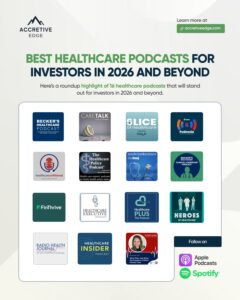Healthcare marketing is in a strange spot right now. Money keeps pouring into campaigns, yet so much of it leaks out at the points that matter most. And while that’s happening, the digital ground keeps shifting underfoot. Platforms, rules, and expectations are all changing at the same time.
The real test in 2026 isn’t about reach. It’s whether healthcare brands can turn that reach into something solid — access, confidence, and a reason for people to stick around.
In this piece, we’ll look at the shifts reshaping healthcare marketing this year, and where the real gains are coming from.
Phone Calls Still Dominate Healthcare Appointments
For all the billions poured into digital, the most important conversion point in healthcare is still the most analog: the phone. Nearly 90% of healthcare appointments are scheduled by phone.
But the phone channel is broken. Almost 29% of calls go unanswered, which translates into hundreds of thousands of dollars in wasted marketing spend every month. Patients notice this. 74% of callers hang up when kept on hold, and about one-third abandon calls within five minutes.
This isn’t a niche problem — it’s likely the funnel. 67% of consumers say they are likely to call when choosing a provider. And yet many healthcare marketers spend heavily on ads and SEO without realizing the bottleneck is the phone line.
What will work in 2026 is no longer just driving calls, but intelligently managing them. Providers that use call tracking and conversation intelligence can see which campaigns generate high-value calls, identify when calls go unanswered, and train staff to convert more of them.
Reviews and Authenticity Shape Patient Choice
The first impression of a provider or health system no longer happens in a waiting room. It happens online, in a search results page filled with star ratings. 84% of patients check online reviews before choosing a provider, and most will only consider doctors with four stars or higher.
Reviews now function as both social proof and a search engine ranking factor. Providers with strong reviews not only look more trustworthy to patients but also rank higher in local search results, driving more clicks and calls.
But reviews are only part of the trust equation. In 2026, authenticity will become the real differentiator. Patients are skeptical of polished ad creative. They respond instead to short physician explainers, patient stories, and even raw, unpolished video that feels more like conversation than advertising.
The backdrop is rising distrust. As of 2022, 70% of consumers reported encountering medical misinformation online, and that share has been rising for the past five years. That makes clear, consistent, and human communication a necessity. Providers and payors that position themselves as transparent, reliable sources will win long-term loyalty.
Digital Advertising Under New Constraints
Healthcare is one of the biggest digital advertisers — 72% of healthcare and pharma ad spend is now online. But in 2026, the digital playbook will look very different from just a few years ago.
In January 2025, Meta rolled out major restrictions on how healthcare advertisers can use website and app data. Lower-funnel tools like pixel-based retargeting and custom conversion events are now blocked or degraded. Campaigns that once thrived on tracking and optimization suddenly lost their precision.
Payors, facing even stricter regulatory risks, have responded cautiously. Some have scaled back or stopped digital advertising altogether as a conservative response to HIPAA compliance concerns.
What’s working instead:
- On-platform lead forms that keep user data inside Meta’s ecosystem.
- Top-of-funnel awareness ads designed to build broad reach and trust instead of relying on retargeting loops.
- First-party, consent-based channels like email, SMS, and member portals, where the flow of data is compliant by design.
The shift is clear: healthcare marketers can no longer depend on microtargeting and behavioral tracking. Better results come with building reach and trust at scale, leaning into storytelling and brand equity instead of surveillance-driven precision.
The SEO and Content Battleground in Healthcare
Even with the rise of social platforms and ad restrictions, the patient journey still starts with a search bar. More than 53.5% of patients in one Emarketer survey, search online before contacting a doctor.
This makes SEO one of the most durable channels in healthcare marketing, but the rules are evolving.
- Local SEO is about presence and proximity. Providers who invest in location-specific landing pages and fully optimized Google Business Profiles consistently win “near me” searches. Reviews play a dual role here: they influence patient trust and also feed search algorithms.
- National SEO is about authority. High-quality, long-form educational content ranks higher, attracts backlinks, and positions providers as trusted resources. Many patients begin their path to care through these guides, long before they’re ready to book an appointment.
- Video has become inseparable from SEO. Short FAQ clips, reels, and explainers humanize providers, while longer-form videos are making a comeback for deeper educational value and better ranking in search results.
The SEO battle isn’t just keywords — it’s authority, authenticity, and format diversity. Combining text, reviews, and video into a consistent presence will help providers shape demand before patients ever pick up the phone.
Marketing and Operations Are Colliding
Healthcare marketers have long been measured on reach and lead volume. But in 2026, the real challenge will not be generating demand — it’s matching that demand to operational capacity. If there aren’t appointment slots or staff available, marketing dollars vanish into wasted calls and frustrated patients.
Forward-looking organizations are breaking down this silo. Providers are now aligning campaigns dynamically with capacity and waitlists, reallocating ad spend to locations that actually have availability.
Responsiveness has also become a brand issue. Research shows that providers who reply quickly to patient messages tend to see higher patient satisfaction. Speed is no longer just a service metric — it shapes trust.
The technology backbone is getting more sophisticated. Customer data platforms (CDPs), call tracking, and AI-driven analytics are allowing organizations to stitch together patient journeys across phone, portal, SMS, and email.
The result is a shift in the role of the healthcare marketer. Success now requires fluency not just in media and messaging, but also in tech, analytics, operations, and patient experience. The marketer of 2026 looks less like a campaign manager and more like a systems integrator.
Payors Search for a New Marketing Playbook
If providers are battling unanswered phones, payors are battling regulation and trust. Health insurers face some of the sharpest marketing constraints in the industry, and many are struggling to adapt.
Only 24% of payors report being fully aware of the risks of PHI-sharing in advertising. The rest are flying half-blind in a regulatory environment where mistakes carry steep fines and reputational costs. Unsurprisingly, more than 50% of payors have paused digital advertising altogether due to compliance concerns.
This cautious stance means that in 2025, many payor campaigns look broad, generic, and risk-averse, undermining both efficiency and impact.
What’s working instead:
- Privacy-first marketing through consent-based channels like email, SMS, and member portals.
- Simplifying plan-switching and enrollment flows may also reduce the inertia that keeps members locked into existing plans.
PR Becomes a Credibility Driver in Healthcare
With digital targeting restricted and patient trust harder to earn, public relations (PR) takes an important role in healthcare marketing. Unlike ads, earned media offers third-party validation that patients and payors see as more credible.
Physicians remain among the most trusted voices in public health, which makes media coverage that features clinicians especially persuasive. At the same time, earned media consistently ranks among the most effective channels for shaping reputation and trust across industries, giving it a unique weight in the marketing mix.
Of course, healthcare PR also operates under strict boundaries. Transparency and accuracy are non-negotiable, with regulations like HIPAA dictating what can be said and how messages are shared. These limits don’t diminish its impact, but rather make clarity and consistency even more essential to building trust.
In 2026, PR will work best when it clarifies, humanizes, and responds quickly to misinformation. Integrated with SEO and content marketing, earned media extends reach while building a depth of trust that advertising alone cannot achieve.
Healthcare Marketing Shifts From Promotion To Infrastructure
The edge in 2026 will belong to organizations that treat access itself as the most powerful form of marketing. Money shifts from media to speed of response, scheduling, and the phone funnel, because every unanswered call funds frustration.
With third-party targeting collapsing, growth now comes from consented channels and creative that proves care rather than promising it. Campaigns are no longer isolated from operations: capacity, call times, and availability flow directly into media decisions.
For payors, the real opportunity lies not in promoting plans but in driving adoption of benefits at the point of care. In short, the competitive advantage in healthcare marketing now comes from designing systems that make care easier to reach, not ads that make it easier to see.






